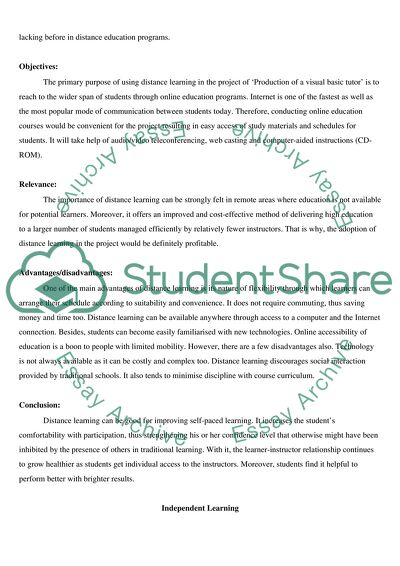
- Home
- Free Samples
- Premium Essays
- Editing Services
- Extra Tools
- Essay Writing Help
- About Us
- Studentshare
- Subjects
- Miscellaneous
- Distance Learning and Independent Learning
Distance Learning and Independent Learning - Essay Example

- Subject: Miscellaneous
- Type: Essay
- Level: Ph.D.
- Pages: 4 (1000 words)
- Downloads: 0
- Author: jonatanbayer
Extract of sample "Distance Learning and Independent Learning"
Technological advancement has created a whole new teaching and learning environment while developing the practice of correspondence study, resulting in the evolution of distance learning. Different educators and researchers seem to have shed their light on defining the very concept of distance learning. As Belanger and Jordan (2000) comment, the popularity of distance learning is growing fast and across the world. While explaining the purpose of distance learning, they provide a comprehensive statement, “Distance learning can bethought of as education or training delivered to individuals who are geographically dispersed or separated by physical distance from the instructor using computer and telecommunication facilities.
” (Belanger and Jordan 2000) While Belanger and Jordan offer a more general outlook, Williams et al (1999) contemplate on the role of technology in distance learning in terms of ‘virtual classrooms’. They talk clearly about the effective change brought by technological advancement, “Today, distance learning environments have continued to evolve with advancing technology, moving toward virtual classrooms where instruction from a host site is delivered to distance sites using a combination of live, two-way interactive audio, video, or both and synchronous/asynchronous computer-based interactions that take advantage of local area networks (LANs), wide area networks (WANs), the Internet, and the World Wide Web (WWW or the Web).
” (Williams et al 1999) Since the arrival of the Internet, distance learning has come a long way. Thanks to the wider prospective of computers and the Internet, distance learning distribution has become a lot more easier and faster. Besides, distance learning has widened the horizon of knowledge by introducing a wide range of new courses to students, providing opportunity and flexibility for both school-age and adult learners alike. With the help of
...Download file to see next pages Read MoreCHECK THESE SAMPLES OF Distance Learning and Independent Learning
The Earnings of an Accountant in a Large Corporation
Distance Learning and Brick-and-Mortar Learning
Independent Learning
Development, Advantages and Disadvantages of Distance Learning
The E-Learning System and Student with Disabilities
Learning Centers in Elementary Education
Distance Learning (Eagle-Vision)
Independent Learning as a Concept

- TERMS & CONDITIONS
- PRIVACY POLICY
- COOKIES POLICY